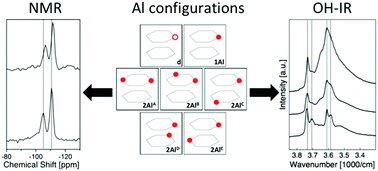Computational description of key spectroscopic features of zeolite SSZ-13†
Abstract
The catalytic properties of zeolites are intimately linked to the distribution and relative positions of Al atoms and defects in the pore network. However, characterizing this distribution is challenging, in particular when different local Al arrangements are considered. In this contribution we use a combination of first principles calculations and experimental measurements to develop a model for the Al-distribution in protonated SSZ-13. We furthermore apply this model to understand trends in OH-IR, 27Al-NMR and 29Si-NMR spectra. We use a Boltzmann distribution to predict the proton position for a given local Al configuration and show that for each configuration several H positions are occupied. Therefore a multi-peak spectrum in OH-IR vibrational spectroscopy is observed for all Al configurations, which is in line with experimentally measured spectra for zeolites at different Si/Al ratios. From NMR spectroscopy we find that the proton position leads to significant shifts in 27Al-NMR and 29Si-NMR spectra due to the modification of the local strain, which is lost when a uniform background charge is introduced. These findings are supported by experimental measurements. Finally we discuss the shortcomings of the presented model in terms of unit cell size and the impact of adjacent unit cells.



 Please wait while we load your content...
Please wait while we load your content...